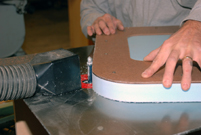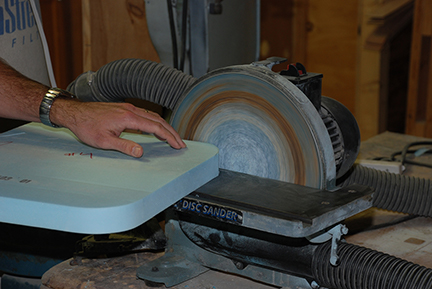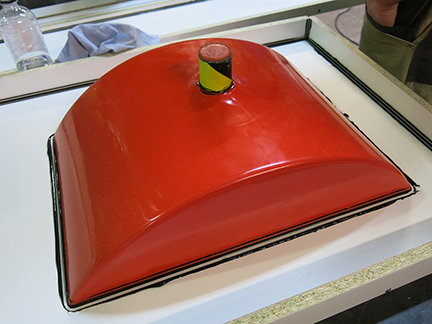There is no one right way! The only requirements for concrete countertop forms are that they be dimensionally correct and made out of materials that will not warp (unless you are using dynamic fabric forming, but that’s another topic).
That said, there are two basic methods to forming, depending on whether you want an as-cast finish (“pop a perfect slab”) or you plan to grind to expose aggregate or create a polished finish (“grind and grout”).
The “Pop a Perfect Slab” Forming Method for Concrete Countertops
If you want to pop a perfect slab, the casting surface must be absolutely perfect, because every little bump, scratch or spot will show up in the cast concrete. Very fluid mixes that can be vibrated to reduce surface pinholes need to be used with this method. These mixes are highly liquid and require watertight forms. You cannot use form release agents in your forms.
I long ago gave up on the pop a perfect slab method. It is simply too difficult to get a perfect, blemish-free, pinhole-free surface on a consistent basis. And, creating perfect, watertight forms is a lot of work. You end up forming and casting multiple times trying to get a perfect finish. I would rather spend time at the end grinding and grouting.
I also feel that this is a more true to concrete look. Why hide the sand grains? Plus, the fine cement skin left on in the pop a perfect slab method is extremely fragile. If that skin is damaged, it is impossible to repair. It also hides tiny pinholes just below the surface.
These pinholes are a reason that some people eschew “grind and grout” and pursue “pop a perfect slab”. However, dealing with pinholes is not that difficult. This article explains exactly to grout to fill pinholes in a concrete countertop. And, pinholes are less of a problem with GFRC, since the surface coat (the mist coat) is generally sprayed onto the surface.
The “Grind and Grout” Forming Method for Concrete Countertops
For the grind and grout method that I prefer, the forms still need to be dimensionally perfect and smooth. But, there is a much wider variety of forming materials you can use and a wider variety of looks you can create.
Following is a brief overview of the forming process for the grind and grout method.
For old school, flat, precast, steel-reinforced countertop slabs, you can use strips of melamine and steel angle iron on a steel-topped casting table.

The melamine is glued down with Power Grab, and the angle iron is clamped onto the edge of the table. Cresset’s Crete-Lease 880 VOC is the form release agent, because it is designed for metal surfaces.
Besides the fact the GFRC is now the preferred method for professionals to create concrete countertops, this also has the big disadvantage that you need a steel-topped casting table.
For GFRC casting, you can simply create melamine boxes. Steel-topped casting tables are not necessary. Form release agent is not necessary unless you are also using fiberglass sink molds, in which case you would use Crete-Lease 20-VOC.
How to Make Sink and Faucet Holes in Concrete Countertops
For sink and faucet knockouts, use blue or pink insulation foam. This foam is the right thickness, easy to work with, and there is no need to tape the edges.
Use a router to cut the foam using a Masonite template as a guide.
Smooth the edges using a disk sander. This will make the edges smooth enough that there is no need to apply tape to them.
Adhere the foam to the form with double-sided carpet tape, and caulk around the edges. See this video for details about caulking.
Integral sinks are typically formed with pre-purchased fiberglass molds. The attachment method is also different and depends on the manufacturer of the mold. Generally these molds are screwed onto melamine form boxes, then caulking is applied.
Whatever sink style, it is extremely important to take great care in placing the sink and faucet holes.
These are the very basic steps of forming. For extensive, detailed step by step instructions for building forms for concrete countertops, undermount sinks, integral sinks, curves and more, consider the online training How to Build Forms for Concrete Countertops.



